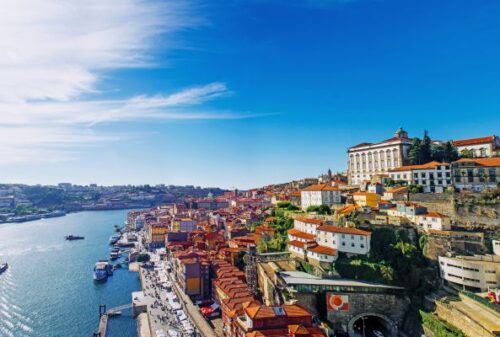Portugal, a gem nestled in the Iberian Peninsula, promises visitors a rich tapestry of experiences. Its diverse landscapes, cultural influences, and history make it a must-visit for anyone with wanderlust. If you’re planning on exploring this beautiful nation, especially during Portugal family vacations, it’s essential to understand the contrasts between its northern and southern regions. This will not only enhance your journey but will also help you decide where to stay in Portugal.

1. Climate and Landscape
Northern Portugal: The north of Portugal, encompassing areas like Porto and the Douro Valley, experiences a maritime climate. Rain is more frequent here, especially during the winter months. As a result, the region is lush and verdant, characterized by rolling hills, deep valleys, and terraced vineyards. The Douro River snakes through this area, giving rise to one of the oldest wine regions in the world, famous for its Port wine.
Southern Portugal: The south, including the famous Algarve region, boasts a Mediterranean climate. This means you can expect warm, dry summers and mild winters. The landscape here is more varied – from the stunning cliffs and beaches along the coastline to the picturesque whitewashed towns and almond orchards further inland.
2. Cultural Influences
Northern Portugal: The northern part of the country is deeply rooted in its traditions. Being closer to Spain, you’ll find a strong Galician influence in the music, dance, and cuisine. Fado, the soulful music of Portugal, originated from the alleys of Lisbon but has strong roots and variations in the north. The cities and towns here wear their history proudly, with ancient fortifications, cathedrals, and baroque architecture.
Southern Portugal: The Moors occupied southern Portugal for longer, and their influence is more pronounced in this region. From the architecture to the food, the Moorish impact is evident. The Algarve, in particular, is known for its chimney stacks, reminiscent of minarets, and the tilework which is characteristic of Moorish design.
3. Gastronomy
Northern Portugal: If you’re a fan of hearty, traditional meals, the north won’t disappoint. With its cooler climate and fertile land, it’s the ideal place for green vegetables, fresh fish from the Atlantic, and rich meats. Iconic dishes include ‘Francesinha’ from Porto, a sandwich loaded with different meats and covered in a spicy tomato and beer sauce.
Southern Portugal: The cuisine of the south leans heavily on seafood, thanks to its extensive coastline. Dishes like ‘Cataplana’ – a seafood stew cooked in a clam-shaped copper pot – and grilled sardines are local favorites. The influence of North Africa is evident in the use of spices like coriander and the ubiquitous almond desserts.
4. Tourist Attractions
Northern Portugal:
- Porto: This UNESCO World Heritage city is famed for its Ribeira District, Livraria Lello (one of the world’s most beautiful bookstores), and its wine cellars.
- Douro Valley: An idyllic location for wine lovers, where you can take boat trips and visit wine estates.
- Braga & Guimarães: Cities steeped in history and religious significance.
Southern Portugal:
- Algarve’s coastline: Famous for its golden beaches, turquoise waters, and dramatic cliffs.
- Faro: A historic town with a beautiful old city and the hauntingly beautiful Chapel of Bones.
- Évora: A UNESCO World Heritage city known for its well-preserved medieval walls and Roman temple.
5. Where to Stay in Portugal
For Portugal family vacations, your choice of accommodation can make a huge difference.
In the north, consider staying in historic manors turned boutique hotels. Quintas (wine estates) in the Douro Valley provide a luxurious retreat with stunning views. Porto, being a cosmopolitan city, offers a range of options from luxury hotels to cozy bed and breakfasts.
In the south, resorts along the Algarve coast cater to families and beach lovers. For a more authentic experience, try the traditional farmhouses converted into tourist accommodations, or stay in the heart of historic towns like Évora.
6. Festivals and Celebrations
Northern Portugal: The northern region is renowned for its vibrant festivals. One of the most notable is the ‘São João Festival’ in Porto, where the entire city comes alive with street parties, fireworks, and the unique tradition of hitting each other on the head with soft hammers. In addition to this, Braga hosts the ‘Semana Santa’ or Holy Week, reflecting its deep-rooted religious heritage with solemn processions and age-old customs.
Southern Portugal: The Algarve region, with its beachy vibe, is no stranger to festivals, especially in summer. ‘Medieval Days in Castro Marim’ is a journey back to the Middle Ages, complete with knights, jesters, and traditional foods. Furthermore, the ‘Festival do Marisco’ in Olhão is an annual celebration for seafood lovers, offering an array of fresh seafood dishes accompanied by music performances.
7. Craftsmanship and Souvenirs
Northern Portugal: Craftsmanship in the north is deeply tied to its history and traditions. Viana do Castelo is renowned for its intricate gold filigree jewelry, a must-buy for those keen on taking home a piece of Portuguese heritage. The Minho region, meanwhile, offers beautifully embroidered linens and scarves, which make for perfect, lightweight souvenirs.
Southern Portugal: In the south, the artistry leans heavily towards pottery and ceramics. The town of Porches in the Algarve is famed for its beautiful, hand-painted pottery. Tiles, or ‘azulejos,’ are another popular souvenir, echoing the Moorish influence with their detailed patterns and bright colors. For a unique memento, consider buying a cork product – from handbags to hats – as Portugal is the world’s leading cork producer.
Conclusion
Both Northern and Southern Portugal offer unique experiences, making it a diverse destination for travelers. Whether you’re drawn to the historic allure of the north or the sun-soaked charm of the south, Portugal promises an unforgettable journey. Happy travels!






